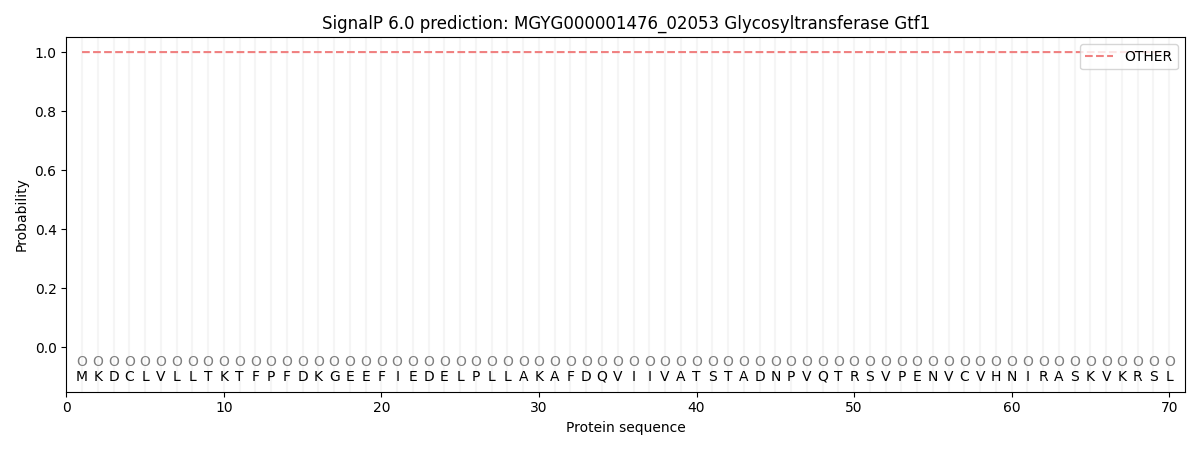You are browsing environment: HUMAN GUT
CAZyme Information: MGYG000001476_02053
You are here: Home > Sequence: MGYG000001476_02053
Basic Information |
Genomic context |
Full Sequence |
Enzyme annotations |
CAZy signature domains |
CDD domains |
CAZyme hits |
PDB hits |
Swiss-Prot hits |
SignalP and Lipop annotations |
TMHMM annotations
Basic Information help
| Species | Caproiciproducens sp000752215 | |||||||||||
|---|---|---|---|---|---|---|---|---|---|---|---|---|
| Lineage | Bacteria; Firmicutes_A; Clostridia; Oscillospirales; Acutalibacteraceae; Caproiciproducens; Caproiciproducens sp000752215 | |||||||||||
| CAZyme ID | MGYG000001476_02053 | |||||||||||
| CAZy Family | GT4 | |||||||||||
| CAZyme Description | Glycosyltransferase Gtf1 | |||||||||||
| CAZyme Property |
|
|||||||||||
| Genome Property |
|
|||||||||||
| Gene Location | Start: 5450; End: 6703 Strand: + | |||||||||||
CDD Domains download full data without filtering help
| Cdd ID | Domain | E-Value | qStart | qEnd | sStart | sEnd | Domain Description |
|---|---|---|---|---|---|---|---|
| cd04946 | GT4_AmsK-like | 3.37e-103 | 4 | 412 | 1 | 401 | amylovoran biosynthesis glycosyltransferase AmsK and similar proteins. This family is most closely related to the GT4 family of glycosyltransferases. AmsK is involved in the biosynthesis of amylovoran, which functions as a virulence factor. It functions as a glycosyl transferase which transfers galactose from UDP-galactose to a lipid-linked amylovoran-subunit precursor. The members of this family are found mainly in bacteria and Archaea. |
| cd03801 | GT4_PimA-like | 2.39e-32 | 144 | 404 | 92 | 355 | phosphatidyl-myo-inositol mannosyltransferase. This family is most closely related to the GT4 family of glycosyltransferases and named after PimA in Propionibacterium freudenreichii, which is involved in the biosynthesis of phosphatidyl-myo-inositol mannosides (PIM) which are early precursors in the biosynthesis of lipomannans (LM) and lipoarabinomannans (LAM), and catalyzes the addition of a mannosyl residue from GDP-D-mannose (GDP-Man) to the position 2 of the carrier lipid phosphatidyl-myo-inositol (PI) to generate a phosphatidyl-myo-inositol bearing an alpha-1,2-linked mannose residue (PIM1). Glycosyltransferases catalyze the transfer of sugar moieties from activated donor molecules to specific acceptor molecules, forming glycosidic bonds. The acceptor molecule can be a lipid, a protein, a heterocyclic compound, or another carbohydrate residue. This group of glycosyltransferases is most closely related to the previously defined glycosyltransferase family 1 (GT1). The members of this family may transfer UDP, ADP, GDP, or CMP linked sugars. The diverse enzymatic activities among members of this family reflect a wide range of biological functions. The protein structure available for this family has the GTB topology, one of the two protein topologies observed for nucleotide-sugar-dependent glycosyltransferases. GTB proteins have distinct N- and C- terminal domains each containing a typical Rossmann fold. The two domains have high structural homology despite minimal sequence homology. The large cleft that separates the two domains includes the catalytic center and permits a high degree of flexibility. The members of this family are found mainly in certain bacteria and archaea. |
| COG0438 | RfaB | 5.13e-27 | 126 | 414 | 79 | 370 | Glycosyltransferase involved in cell wall bisynthesis [Cell wall/membrane/envelope biogenesis]. |
| pfam00534 | Glycos_transf_1 | 1.30e-26 | 235 | 396 | 1 | 158 | Glycosyl transferases group 1. Mutations in this domain of PIGA lead to disease (Paroxysmal Nocturnal haemoglobinuria). Members of this family transfer activated sugars to a variety of substrates, including glycogen, Fructose-6-phosphate and lipopolysaccharides. Members of this family transfer UDP, ADP, GDP or CMP linked sugars. The eukaryotic glycogen synthases may be distant members of this family. |
| cd03808 | GT4_CapM-like | 4.52e-23 | 159 | 404 | 100 | 351 | capsular polysaccharide biosynthesis glycosyltransferase CapM and similar proteins. This family is most closely related to the GT4 family of glycosyltransferases. CapM in Staphylococcus aureus is required for the synthesis of type 1 capsular polysaccharides. |
CAZyme Hits help
| Hit ID | E-Value | Query Start | Query End | Hit Start | Hit End |
|---|---|---|---|---|---|
| QEY34424.1 | 3.45e-230 | 1 | 417 | 1 | 417 |
| AJF30737.1 | 2.28e-185 | 1 | 415 | 1 | 415 |
| ACD53904.1 | 2.28e-185 | 1 | 415 | 1 | 415 |
| AJF33800.1 | 2.28e-185 | 1 | 415 | 1 | 415 |
| AIY82178.1 | 1.82e-182 | 1 | 416 | 1 | 415 |
PDB Hits download full data without filtering help
| Hit ID | E-Value | Query Start | Query End | Hit Start | Hit End | Description |
|---|---|---|---|---|---|---|
| 4XYW_A | 1.90e-08 | 249 | 363 | 192 | 292 | GlycosyltransferasesWbnH [Escherichia coli] |
| 2F9F_A | 5.13e-07 | 240 | 387 | 27 | 168 | CrystalStructure of the Putative Mannosyl Transferase (wbaZ-1)from Archaeoglobus fulgidus, Northeast Structural Genomics Target GR29A. [Archaeoglobus fulgidus DSM 4304] |
Swiss-Prot Hits download full data without filtering help
| Hit ID | E-Value | Query Start | Query End | Hit Start | Hit End | Description |
|---|---|---|---|---|---|---|
| P9WMY8 | 3.22e-08 | 186 | 390 | 163 | 367 | Glycogen synthase OS=Mycobacterium tuberculosis (strain CDC 1551 / Oshkosh) OX=83331 GN=MT3116 PE=3 SV=1 |
| P9WMY9 | 3.22e-08 | 186 | 390 | 163 | 367 | Glycogen synthase OS=Mycobacterium tuberculosis (strain ATCC 25618 / H37Rv) OX=83332 GN=Rv3032 PE=1 SV=1 |
| P0DMP6 | 1.04e-07 | 249 | 363 | 192 | 292 | O-antigen biosynthesis glycosyltransferase WbnH OS=Escherichia coli OX=562 GN=wbnH PE=1 SV=1 |
| P0DMP7 | 1.04e-07 | 249 | 363 | 192 | 292 | Probable O-antigen biosynthesis glycosyltransferase WbiN OS=Escherichia coli OX=562 GN=wbiN PE=3 SV=1 |
| O05083 | 8.23e-07 | 239 | 363 | 184 | 305 | Uncharacterized glycosyltransferase HI_1698 OS=Haemophilus influenzae (strain ATCC 51907 / DSM 11121 / KW20 / Rd) OX=71421 GN=HI_1698 PE=3 SV=1 |
SignalP and Lipop Annotations help
This protein is predicted as OTHER

| Other | SP_Sec_SPI | LIPO_Sec_SPII | TAT_Tat_SPI | TATLIP_Sec_SPII | PILIN_Sec_SPIII |
|---|---|---|---|---|---|
| 1.000073 | 0.000000 | 0.000000 | 0.000000 | 0.000000 | 0.000000 |
